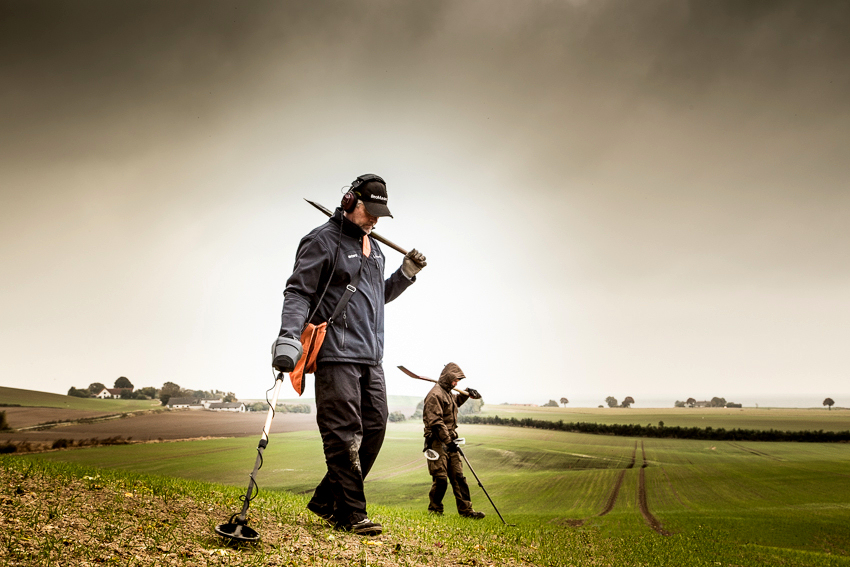New digital tool sparks enthusiasm among metal detectorists
On 20 September, the new digital platform DIME was launched in Denmark. DIME is a digital portal for registration of the growing number of metal detector finds in Denmark. DIME allows amateur archaeologists to register their finds in the field and send their data to the museums. The museums can then build on the data provided by the amateur archaeologists and their vast knowledge of the finds. The launch of DIME means that an important part of the Danish cultural heritage is made public, and it will be easier for the museums to keep abreast of the many new discoveries.

World amateur archaeology champions
Denmark is internationally renowned for its metal detector archaeology and has some of the most competent and committed amateur archaeologists in the world. They continuously contribute to the discovery of some of the most sensational finds in Danish archaeology, and in many ways they have helped rewrite Danish history. But only a fraction of the many finds are available to the general public and to research today. Aarhus University, Moesgaard Museum, Odense City Museums and the Historical Museum of Northern Jutland have developed the digital platform DIME in collaboration with the KROGAGERFONDEN foundation. It builds a digital bridge between amateur archaeologists and the museums and the general public. This way, an important part of the Danish cultural heritage becomes available to the general public, and it will be easier for the museums to register the increasing number of metal detector finds.
"For a long time, detectorists have been looking forward to the development of a digital portal for registering finds. DIME is easy to use and has so many helpful functions that make it fun to use. I’m happy that we can now start using it,” says Freddy Arntsen, detectorist and representative of the Association of Danish Amateur Archaeologists on the DIME steering committee.
“Danish metal detection archaeology is the best example of the broad popular involvement in our cultural heritage. It’s also an expression of the special Danish culture of trust where everyone protects and contributes to the shared cultural heritage, and where professionals are also prepared to leave responsibility to the volunteers. We’re now taking this collaboration to a higher level with DIME. We will create an even stronger connection between the many volunteers and the museums, and we will get new tools that help us gain an overview of the many new finds and share our knowledge,” says Mads Kähler Holst, executive director, Moesgaard Museum.
Democratic cultural heritage management
Many amateur archaeologists have acquired significant knowledge of their finds, and the communication in the environment is a textbook example of efficient knowledge sharing. DIME allows metal detectorists to actively bring their knowledge into play for the benefit of society as a whole. This makes the portal one of the biggest crowd-sourcing and citizen-science projects ever in archaeology.
DIME will give all Danes the opportunity to learn more about the many new and exciting detector finds discovered by the many detectorists every day. In future, for example, a school class will be able to explore the many finds from the Viking Age and other periods and see what has been found in their local community.
“The idea which DIME is based on is simple and brilliant, and we hope that DIME is one of the keys to solving the challenge that we and other museums are facing with the increasing number of detector finds. Today, amateur archaeologists are often just as competent as the professionals are. This is especially true of Danish detectorists, and it’s simply a matter of acknowledging them and giving them the chance to bring their vast amount of knowledge into play,” says Rane Willerslev, director, National Museum of Denmark.
Facts
● Financing: The development of DIME is financed by KROGAGERFONDEN
● IT development: DIME is developed by Archaeological IT (Moesgaard Museum and Aarhus University)
● Broad collaboration: DIME is developed by Aarhus University, Moesgaard Museum, Odense City Museums and the Historical Museum of Northern Jutland in collaboration with the Association of Danish Amateur Archaeologists (SDA), the National Museum of Denmark, and the Agency for Culture and Palaces.
● Metal detectorists: It is estimated that there are approximately 4,000 detectorists in Denmark.
● Archaeological finds and treasure troves: In 2016 and 2017 alone, Danish metal detectorists handed in more than 31,000 finds for treasure trove evaluation. This, however, is only a fraction of the actual number of finds discovered by detectorists.
● The role of the museums: All Danish museums are invited to participate in DIME. For the Danish museums, the ever-growing number of metal detector finds is a major challenge. It is estimated that the Danish local museums in 2016 spent a total of 7.9 full-time equivalents on handling amateur archaeologists’ detector finds.
● Europe: DIME is part of the European Year of Cultural Heritage 2018.
● For more information on the rules for metal detector archaeology in Denmark
● For more information on Danish metal detector archaeology in general
Kontakt
Projektleder
Andres Dobat
Lektor i Arkæologi ved Institut for Kultur og Samfund, Aarhus Universitet
Mail: farkado@cas.au.dk
Tel: 41118689
